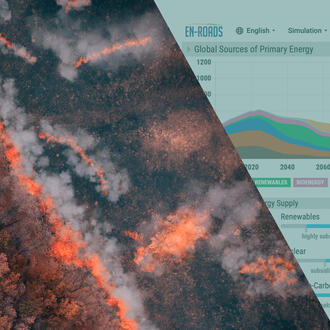Credit: fullframes / Shutterstock
Mention artificial intelligence and climate change in the same sentence, and discussion most often turns to the energy intensity of large language models — how much CPU power they require and how much carbon that emits.
Priya Donti, an MIT professor and the co-founder and executive director of Climate Change AI, a global nonprofit, offers an alternative view.
Speaking at this year’s ClimateTech conference, hosted by MIT Technology Review, Donti said that not every application of AI requires immense amounts of energy. “There are a lot of models that can run on a laptop,” she pointed out.
More important, AI has vast potential to accelerate the search for solutions to the climate crisis. Drawing from “Tackling Climate Change With Machine Learning,” a 2022 paper she co-authored with 21 fellow researchers, Donti highlighted ways in which AI is helping scientists and policymakers think through and address the challenge of climate change:
- Gathering and analyzing data. The quantity of climate-related data produced far exceeds the human capacity to analyze it. Donti pointed to satellite imagery as one example — a firehose of pictures that show agricultural land, say, or forest cover around the world. In these cases, AI can be deployed to assess what kinds of crops are being grown where and what adaptation measures should be put in place in light of climate projections, or to analyze trends in deforestation and reforestation.
- Forecasting. AI can be instrumental in creating various types of forecasts. The nonprofit Open Climate Fix, for instance, uses a combination of historical data and satellite images of cloud cover to derive estimates that better match near-term solar power production with electricity demand. AI can also be used to predict demand for transportation infrastructure or the probability of extreme weather events.
- Improving systems efficiency and predictive maintenance. AI has a growing role to play in optimizing systems, such as freight transportation, food refrigeration, and heating and cooling in buildings. “A very unsexy but related application of AI and machine learning is predictive maintenance,” Donti said. For instance, AI can be used to detect and patch methane leaks in natural gas infrastructure before they worsen, thus preventing methane from leaking into the atmosphere.
- Facilitating the invention of next-generation technologies. AI can be used as a sort of scientific assistant. Donti described how researchers at Stanford used AI to help companies manufacture batteries more efficiently by analyzing the outcomes of past experiments. The project reportedly reduced the number of design cycles by a factor of 10.
Three key challenges that remain
Despite these promising developments, Donti highlighted three impediments to the use of AI in developing climate solutions.
First and most explicit is that machine learning is being used on the other side of the balance. “The canonical example is AI being used to accelerate oil and gas exploration and extraction in a way that is projected to create $400 billion of profit for the oil and gas industry by 2025,” Donti said.
But there are more subtle cases, too, like the use of AI in targeted advertising, which drives consumption; or in developing autonomous vehicles, which Donti said “support individualized transit as opposed to multimodal public transit.”
Related Articles
Second, as the use of artificial intelligence increases and demand for computing power rises, there is the question of AI’s carbon footprint. The impact in 2019, Donti noted, was relatively small: The global information and communications technology sector accounted for 1% to 2% of greenhouse gas emissions, and AI was responsible for a small fraction of that. But as AI’s use becomes more pervasive and the models grow in power, its contribution should be more carefully quantified and tracked, she said.
Third is the challenge of accuracy, particularly as it relates to infrastructure and public safety. For example, Donti studies the use of machine learning to optimize and control power grids, which have “hard constraints.” If you don’t get the physics right, the result of AI optimization could be a blackout, with related economic losses and even loss of life — “things you really don’t want,” she said.
But AI works in averages: It learns to recognize a cat through training on lots of cat images. “And an algorithm’s success is usually [based] on how often it was right about an image being a cat, not on how catastrophically wrong it was that one time when it said something wasn't a cat,” Donti said.
With regards to a power grid, even one catastrophic failure is enormously problematic. “And so you need to bake in harder physical constraints to make sure that you’re not crossing those boundaries by accident with a model that is optimized for average goodness,” Donti said.
Cause for optimism?
Despite these challenges, Donti is hopeful about the application of AI to address the climate crisis. Venture capital investment in climate technologies reached an all-time high at the end of last year, and Donti is among the industry watchers who expect this year’s numbers to be higher.
Although “the climate tech company ecosystem is a lot bigger than it used to be,” Donti said, a lot of work remains to be done to build capacity, educate the public, and democratize solution-making, which is where her organization comes in. “A group of us co-founded Climate Change AI to bring together innovators, practitioners, and decision makers working at this intersection of AI and climate change.”
Read next: How platforms can power the circular economy



